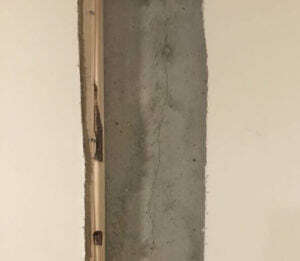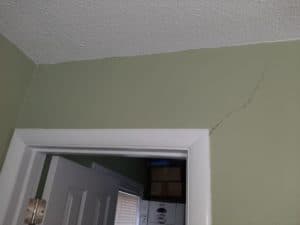
Originally posted 1/14/2019, updated 4/16/2021
Repair methods for foundation problems will vary, depending on what the issue is and how severe it is. The important thing that homeowners need to understand is this: most foundation repair should be left to the professionals. You can easily find videos on the internet that indicate you can make your own repairs, but obtaining professional quality results is unlikely, and will leave you without the warranty a pro should provide.
Please understand that we are not saying there’s nothing you can do to improve your foundation, or to reduce the chances of developing foundation damage. But once cracks form or water intrudes, you need to contact a qualified contractor. Most of the products and equipment used to effectively make these repairs are not available to the general public.
Acculevel is a family-owned and operated company, started by Andy Beery in 1996. We specialize in foundation repairs and waterproofing, and we want to help homeowners protect their greatest investment from avoidable problems. We also want to help homeowners determine when they need to consult a professional to address their concerns.
In this article, we’ll review the most common foundation problems, provide information on the best repair method(s), and detail steps you can take to avoid encountering these problems.
Many foundation cracks are created by hydrostatic pressure. This is the force of water in the ground pushing against your home. Cracks generally begin as hairline (super thin) cracks. Hairline cracks may -or may not- allow water into your basement or crawlspace.
The other major cause of cracks in your home and foundation is uneven settling. All homes settle, but when one section settles faster or deeper into the earth, it causes issues for the building’s structure. We’ll discuss settling after we explore hydrostatic pressure, but if you’d like a comparison between the two causes, we discuss that more in this blog.
 This photo was taken by an Acculevel project manager during a free estimate appointment. You can see the section of wet drywall has been cut away to expose the long thin hairline crack.
This photo was taken by an Acculevel project manager during a free estimate appointment. You can see the section of wet drywall has been cut away to expose the long thin hairline crack.
For thinner cracks, foundation repair contracts use a variety of methods. Acculevel prefers to use epoxy as our fill material, because it provides a superior seal and can be painted over to be less obtrusive.
If a hairline crack is left untreated, it will widen and spread over time. A larger crack can translate to a less stable wall, and instability is not a desirable trait in your foundation.
 This photo was taken by an Acculevel project manager during a free estimate appointment. There are multiple cracks in this basement, and both the long horizontal and zig-zag cracks are signs of hydrostatic pressure forcing the wall to bow inward.
This photo was taken by an Acculevel project manager during a free estimate appointment. There are multiple cracks in this basement, and both the long horizontal and zig-zag cracks are signs of hydrostatic pressure forcing the wall to bow inward.
If you have a long horizontal crack in a poured concrete wall, we will recommend repairing it with carbon fiber straps. In foundations made of concrete block, you may see either a horizontal crack or a stair-step (zig-zag) crack. Block foundations can also have both types of crack, as demonstrated in the photo above. Regardless of which type of foundation crack you have, it is essential that you have it repaired before it gets any worse.
If you have a foundation wall that is actively leaning inward, you need to take action at once. I’m not saying this to be an alarmist, or to scare you into spending money; I’m saying this because that wall is a genuine concern for the safety of your home.
I’ve heard homeowners before shrug off concerns, “it’s been like that for years and it’s been fine.” But once a wall is compromised, it’s an ongoing risk. All it will take is a thunderstorm with the right intensity, and you could have water flooding through the crack… or worse.
The costs to repair a bowing wall, with either wall anchors or helical tie-backs, is far less than the expense of re-building it.
You may have noticed that the pictures I provided are taken from the interior of the home. This is because exterior cracks can indicate either settling or hydrostatic pressure. But there are specific signs inside your home that will help determine which cause is at fault.
As I mentioned earlier, if one section of your foundation is settling at a different rate than the rest, it will cause undue stress on the rest of your home. Building materials are not flexible- and they’re not supposed to be! But this means when a section “pulls,” the bulk of the home tries to resist it and stand firm. It’s this conflict that causes settling cracks, which can be found outside on the foundation and on the interior walls.
 This photo was taken by an Acculevel project manager during a free estimate. This door is difficult to close, and there is a crack in the drywall above it.
This photo was taken by an Acculevel project manager during a free estimate. This door is difficult to close, and there is a crack in the drywall above it.
Another clear sign is if you have any doors or windows in the same area that ‘stick.’ Window and door frames start to shift or twist when settling occurs, making opening and closing the doors and windows difficult.
If you are dealing with water, as well as cracks in your foundation, you should consider installing water drainage. This would not only manage the water invading your home, but also relieve the hydrostatic pressure that is forcing the cracks to develop.
We explore the costs and components of basement waterproofing in our detailed guide, which is available free to you. It is meant to be a homeowner’s resource, so please bookmark it and reference it as you have questions.
If your home has a crawl space and you’re getting water intrusion, you need to take action promptly. There’s a smaller gap between the “floor” and “ceiling” of your crawl space; on average, crawl spaces are 18-36 inches tall. That means any water under your home is in much closer proximity to the wooden components of your home’s floor.
Moisture is the number one enemy of your crawl space. It will cause the joists, sill plate, and other wooden components to mold, rot, and decay- leading to very poor air quality, potential insect infestations, and sagging floors. We detail how and why water is a major threat to your wooden flooring structure in this article.
We have developed a thorough guide that will help a homeowner conduct their own foundation inspection. Please take full advantage of this opportunity to flex your DIY muscles and catch any issues early in development. We recommend performing this inspection twice per year, normally in the spring and fall.
If you have noticed any possible symptoms, and would like more information, you can always evaluate them with another of our free resources: the symptom checker. This allows you to select a possible concern and conduct more research about it from the comfort of your own home.
You should find a qualified professional contractor. Please verify the company is reputable, insured, and accredited by the Better Business Bureau. If you’re not sure how to conduct an “interview” with potential contractors, we have a free downloadable list of questions to ask. This list is the product of multiple discussions with all of our staff, from customer service, to sales, to installation, and even accounting. We wanted to cover all aspects of the process, to protect homeowners from being deceived by an unethical person mimicking a true professional contractor.
If you live in Indiana or the surrounding states, contact Acculevel. We provide free estimates to all of our customers. One of our experienced project managers will evaluate your home and recommend the best course of action for you.